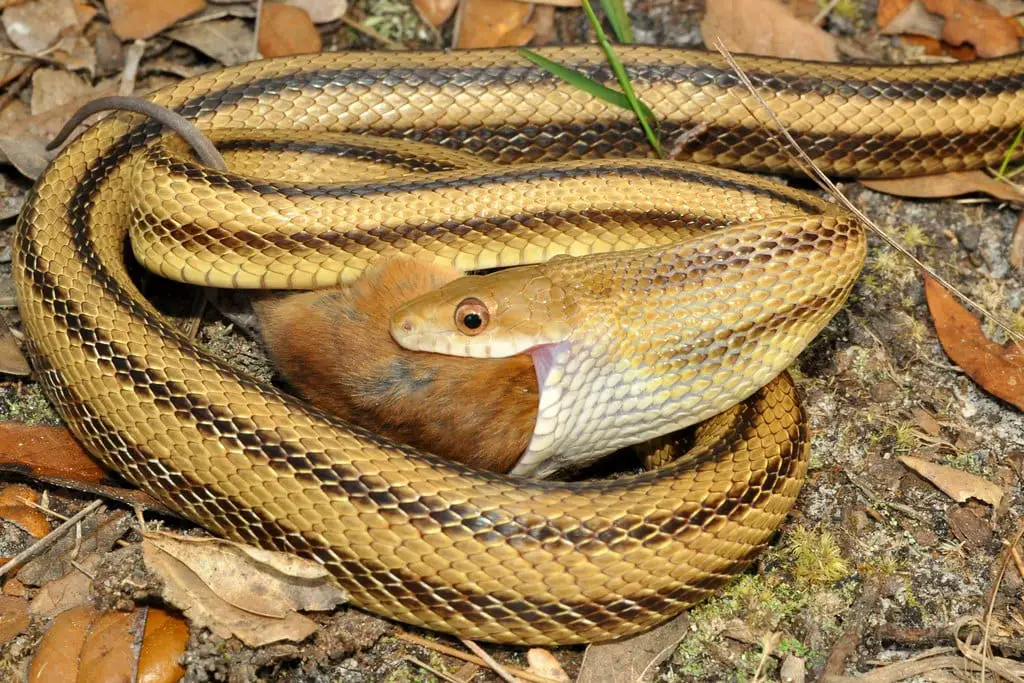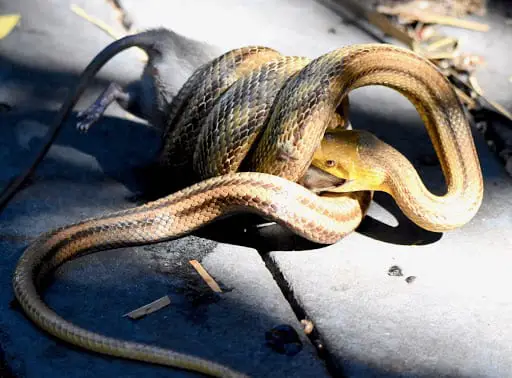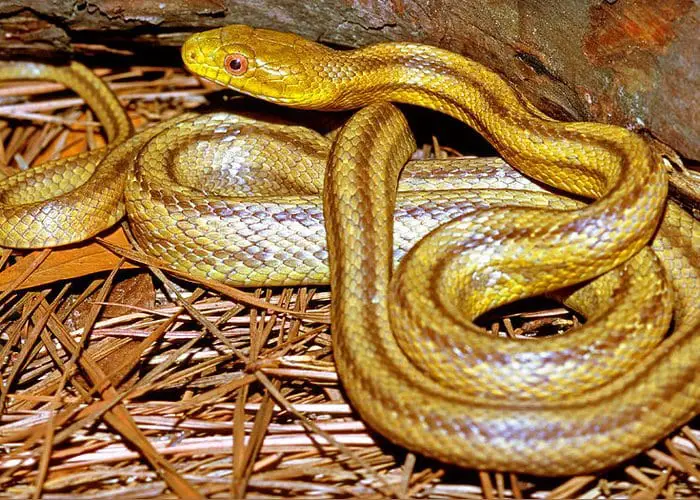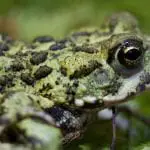Scientific Facts
| Common Name | Yellow Rat Snake, Eastern rat snake, chicken snake |
| Scientific Name | Pantherophis alleghaniensis |
| Captive Lifespan | 12 to 20 Years |
| Size | 40 – 70 inches (101.6-177.8 cm) |
| Mass | No data |
| Habitat | Pine flatlands and shrubs, cypress swamps, forests, abandoned pastures and buildings, citrus groves |
| Country of Origin | United States of America; coastal North Carolina – southeastern Georgia – Florida peninsula |
Physical Description

One of the most common kinds of rat snakes sub-species is the yellow rate snake.
Yellow rat snakes typically reach five to seven feet on an average, although there have been recorded cases of yellow rat snakes growing as big as up to 10 feet.
Yellow rat snakes are nonvenomous. On rare occasions, some yellow rat snakes in the wild have been found to possess only very small doses of venom, though.
Usually, these serpents are colored with tins of both orange and yellow, and their bodies tend to be rather greenish.
There are four distinct dark stripes that run along the length of a yellow rat snake’s body.
Depending on the region where a yellow rat snake can be found in the wild, the stripes are known to come in slightly different colors. For instance, the stripes of northern yellow rat snakes are dark yet quite poorly defined, unlike the stripes of central area yellow rat snakes that come in olive-brown, well-defined coloration.
The physical appearance of baby yellow rat snakes differs from that of mature species; for example, the stripes’ color does not vary as much as that typical for adults. Also, the stripes of baby yellow rat snakes are usually way darker than the coloration of adults’ stripes.
The head of a yellow rat snake is often speckled with a spear point pattern, as well as a dark band.
Types
Rat snakes are renowned as one the largest kinds of species of snakes. There are over 50 types of sub-species, one of which is the yellow rat snake.
The different types of rat snakes do greatly vary in appearance, too, as some possess stripes, blotches, or a combination of both, while some can be single-colored. The coloration of rat snakes can be red, brown, yellow, black, or gray.
Black rat snake
(Elaphe obsoleta / Pantherophis alleghaniensis)
Black rat snakes are shiny and primarily colored in black, with a white chin, and most commonly a white belly. When the skin of black rat snakes is stretched, for instance, after a meal, spotted patterns can be noticed, ranging in the coloration of yellow, orange, red, or white.
Yellow rat snake
(Elaphe obsoleta quadrivittata / Pantherophis alleghaniensis quadrivittata)
The yellow rat snake is a morph of the black rat snake. Since the black rat snake is commonly referred to as an eastern rat snake, this particular naming is often used to refer to yellow rat snakes, too. Apart from the total of four narrow stripes, another distinct trait of yellow rat snakes are their yellow irises.
Texas rat snake
(Elaphe obsoleta lindheimeri / Pantherophis obsoleta lindheimeri)
Right beneath their scales, Texas rat snakes have reddish orange-colored skin. Their heads are typically grey in color, and their bellies vary from grey to white. Texas rat snakes are also known to possess splotchy patterns.
Gray rat snake
(Pantherophis spiloides / Elaphe spiloides)
Grey rat snakes are the largest snakes found in Canada. Just like the name implies, their coloration is greyish, with dark grey or black blotches located on the belly and back zones. Juvenile grey rat snakes are vividly patterned. However, their coloration fades as they reach maturity.
Red rat snake
(Elaphe guttatus / Pantherophis guttatus)
The red rat snake is a common nickname for corn snake. Red rat snakes have orange or yellowish bodies, with dark marks in the belly zone, a distinct V-shape on the very top of the head, and red blotches on the back zone.
Habitat & Lifespan
Yellow snake species are known as native inhabitants of certain regions within the United States, commonly the coastal areas. However, yellow rat snakes can be also found in some regions across Europe, too.
The most populated area inhabited by yellow rat snakes is that along the Savannah River in Carolina, as well as in southern Georgia.
The natural habitat of yellow rat snakes includes thick forests, swamps, floodplains, and timbered hills, whereas yellow rat snakes inhabiting suburban areas can be typically found in abandoned buildings and farmhouses.
Yellow rat snakes have a solid reputation as excellent swimmers, so it comes as no surprise that they are most commonly found near water sources. When not in hunting mode, yellow rat snakes enjoy hanging high in the trees, specifically cypress oak trees.
The lifespan of these mesmerizing creatures can vary based on different factors. In general, yellow rat snakes live for 12 to over 20 years on average.
Behavior
Depending on their location, yellow rat snakes may choose to hunt during the day or during the night. However, in general, yellow rat snakes are nocturnal creatures, and they are most active during the dark hours, starting from dusk to late at night/ early morning.
Apart from their hunting preferences, the habits and behavior of yellow rat snakes do greatly depend on where they originate from. For instance, yellow rat snakes found in the south are known to be more aggressive than those inhabiting the northern regions.
The reasons for the differences in the behavior and habits of yellow rat snakes based on the region where they originate from remains a secret to scientists up-to-date. However, experts believe that the differences in behavior may have much to do with the differences in the serpents’ diet based on their area of residence.
Adult yellow rat snakes are less prone to bite in defense than babies. Also, wild yellow rat snakes tend to be much more defensive than those bred in captivity.
It is during feeding time when yellow rat snakes tend to become more aggressive.
The defensive posture that yellow rat snakes use in order to fend off humans and/or other predators is referred to as a kink.
A yellow rat snake is in a kink when it moves into a curved position. This typically happens when the serpent is sleeping but also happens when it is freighted. The very goal of this defensive position is to make the yellow rat snake appear as a fallen branch.
Caging
1. If you wish to display a yellow rat snake, then the best option is to choose to a cage made out of glass. Glass tanks have many advantages, such as making feces easier to spot. Nonetheless, glass-made terrariums can be a fantastic focal point in just about any room.
2. The most widely preferred type of heating for caging yellow rat snakes is under tank heating. It is good to mind that this type of heating works best with tanks made of glass.
3. Yellow rat snake keepers need to opt for a minimum of 5 – 6 feet long tank.
4. Since the serpent’s cage must be cleaned monthly, dealing with the rather heavy glass tanks may indicate quite some hard work to be done. For keepers who would prefer caging that is easier to handle, HDPE plastic cages can work great.
5. HDPE plastic tanks retain heat better than glass tanks.
6. If you are to choose a glass tank with screen lids, then keep in mind that temperature and humidity must be monitored on a daily basis.
7. A wooden enclosure can offer the best heat retention for a yellow rat snake’s well-being, and it also offers superior security. Thanks to the sliding lids, wooden enclosures are easy to clean and access, too.
8. With wooden enclosures, keepers should be extra careful about possible bacterial contamination due to poor sealing. Porous wood tends to club with humidity, therefore, becoming a magnet for nasty bacteria to develop.
9. With wooden enclosures, it is a must to make sure that the wood is well-treated so that it does not emit toxic, harmful fumes.
10. Make sure you aim for floor space as opposed to height space.
Substrate
Yellow rat snakes love to explore their environment, and they also adore to burrow. Because of this, caregivers should select a substrate that will allow for these whimsical serpents to follow their natural instincts while being hypoallergenic and easy to clean and maintain at the same time.
Newspapers
Newspapers make up for an easily replaceable, cheap substrate that is also easy for the snake to burrow and dig through. On the downside, newspapers tend to get soaked with both must and excretion, leading to unwanted odor lingering in the tank if this type of substrate is not changed as soon as feasible.
When it comes to juvenile yellow rat snakes, newspapers should be replaced even more frequently, as juveniles are known to musk at the smallest threat they are to possibly perceive.
Aspen shavings
Aspen shavings are affordable, easy to replace, and nonetheless, aesthetic. They are also very easy to burrow through. Moreover, aspen shavings allow for the cage to be well-ventilated.
Mind that if the chips are too small, there is a high risk for the yellow rat snake to accidentally swallow the pieces while feeding.
The best move is that owners using aspen shavings as substrate are to feed the snake outside the enclosure.
Another option is to ensure that the snake’s food is as dry as a bone, as to limit any chances for the reptile to accidentally swallowing particles along. Experts have reached a consensus that the occasional ingestion of tiny aspen shavings pieces is not harmful to the yellow rat snake’s health and well-being.
Coconut fiber
Coconut fiber is ultra-lightweight, easy to clean, and very aesthetic. On the downside, it is also costlier than other substrates. Plus, as it tends to soak water, keepers must be extra diligent when it comes to regular monitoring and regulation of the humidity levels within the enclosure.
Hemp Bedding
Hemp bedding is a relatively new material with excellent qualities when it comes to a suitable substrate for a captive yellow rat snake. Hemp bedding absorbs odors wonderfully, it is soft and very easy to burrow. Nonetheless, hemp bedding is 100% biodegradable.
Important Note:
Anything that can get trapped between the yellow rat snake’s scales, such as soil or sand, must be avoided. Furthermore, the mind that aromatic, oily woods like pine, fir, and cedar, can lead to serious allergies and/or irritations on the serpent’s skin.
Temperature, Lighting & Humidity

Temperature and Lighting
1. Rat snakes are ectothermic, meaning that their bodies cannot produce heat, and so they rely on environmental temperature for the purpose of keeping their metabolism well-functioning. Because of this, keepers must be very precise at simulating the temperatures that are typical for the natural habitat of yellow rat snakes.
2. In order to allow thermoregulation, there need to be two distinct thermal zones maintained within the enclosure, also known as a temperature gradient.
3. Over Tank, heating can be an easy solution to heat one end of the snake’s enclosure by hanging a spot bulb and a thermometer 1 – 2 inches above the substrate layer.
However, OT heating is generally considered unsafe, as it may easily emit more heat than what is required for the yellow rat snake’s well-being. This can lead to dehydration, and in extreme cases, to kidney damage. You can hang a spot bulb, and the temperature can be monitored using a thermometer hanging an inch or two above the substrate layer.
4. Under Tank, heating is the superior choice as it provides a good simulation of the way a yellow rat snake achieve the ideal body heat in the wild, thanks to a buffer layer produced by the substrate which prevents the temperatures from rising way above the recommended rates.
5. With Under Tank heating pads, caregivers should keep in mind that the pad must cover ¼ of the total area of the enclosure or less.
6. Yellow rat snake caregivers should always use three thermometers in order to monitor and maintain the temperature. One should be positioned at the warm end of the enclosure, one near the basking site, and one at the cooler end of the tank.
7. Over one side of the cage, yellow rat snake keepers should put 100-watt bulb for adults and 75-watt bulb for young serpents. In the case, you notice that the snake often leans towards the lamp, slightly increase the wattage.
8. Yellow rat snakes do not require UVB lighting. However, it is perfectly fine to use UVB lighting for the purpose of sustaining the live plants within the enclosure, as well as for a more natural feeling of the snake’s environment.
9. When it comes to the hot (basking) side, temperatures should be kept between 85-90 degrees Fahrenheit.
10. On the cool side, temperatures should be kept within the 70-75 degrees Fahrenheit range.
Humidity
1. As far as humidity levels are concerned, most rat snakes, including but not limited to yellow rat snakes, are the least demanding types of colubrid serpents.
2. Humidity levels between 40% – 50% are ideal for a yellow rat snake pet. These levels are easy to achieve by simply placing a large water bowl within the enclosure.
3. In the case you notice that humidity levels are dropping lower than 40% despite having placed a large water bowl inside the tank, you can use a mister or a fogger. Using a pump sprayer every 4 days with 5-10 pumps should be plenty to maintain proper humidity.
4. Yellow rat snake keepers can also choose to spray water daily to help maintain the optimal humidity levels. However, doing so can easily get the substrate soaked with water, and in return, to make the humidity rates more difficult to handle and adjust properly.
5. In order to maintain humidity levels, always use a reliable hygrometer.
Diet
Just as the very name indicates, the favorite food of yellow rat snake is none other but rats.
The diet of yellow rat snakes also consists of rodents, such as chicks and mice, as well as various types of smaller birds. Young yellow rat snakes feed predominantly on lizards and tree frogs.
Because of the aptitude of being able to swallow quite large prey, yellow rat snakes’ diet is very wide-ranged. In the wild, these beautiful creatures primarily feed on squirrels, rats, mice, and bird eggs.
Eating Habits

1. Hatchlings or neonates should be best fed with pinkies twice a week. Provided a good diet is followed, they should grow into healthy adults within about four years.
2. Sometimes, hatchlings may refuse to take pinkies. In such case, rub a frozen frog onto the pinkies in order to scent them. You may need to go through several attempts before the hatchling accepts this type of meal, so be patient.
3. For adult rat snakes, keepers are highly recommended to follow a weekly feeding schedule.
4. Feed adults a size-appropriate rat, and then wait for a few days until the snake excretes the meal (it typically takes a day or two). Excretion is a clear signal of the end of the digestive cycle, meaning that the snake is ready to be fed again.
Sleeping Habits
In general, rat snakes are known to hibernate in cold climates annually.
However, for captive yellow rat snakes, hibernation is not needed. In the hot summer months, yellow rat snakes will usually become more active at night.
Water
1. Keep a large bowl of fresh, clean water in the yellow rat snake’s enclosure at all times. Change the water on a daily basis.
2. Choose a water bowl that is tip-free, deep, and sturdy.
3. Make sure that water will not overflow whenever the reptile is to enter the bowl. The bowl should be large enough for the reptile to soak in whenever it needs to self-regulate body humidity.
Development and Reproduction
In comparison to other snakes, the life expectancy of yellow rat snakes is quite large, and this has much to do with their varied diet.
Also, because baby rat snakes have a different diet than that of adults, this removes competitiveness, and so adult yellow rat snakes are less likely to eat their young, unlike many other snake species.
Yellow rat snakes breed at least once annually, and this is the time when these serpents become far more aggressive than usual.
Being oviparous, yellow rat snakes lay eggs that need to spend little to no time of incubation inside the mother’s body.
Provided the right conditions, females may lay two clutches of eggs per year, although they typically lay one.
The mating season is usually in the late spring.
Five weeks after mating, females lay about 12 to 20 eggs in a hidden spot.
The young yellow rat snakes would then hatch after two months on an average. Rat snakes, in general, are known to offer no parental care to their babies.

How to Breed
Yellow rat snakes are iteroparous, meaning that their reproductive cycles are repetitive, as well as predictable. This makes it fairly easy for keepers to breed them, even if the keepers are first-time reptile pet owners.
Yellow rat snakes reach sexual maturity when they turn 2-3 years old.
Sexually mature yellow rat snakes usually mate without any external interference or assistance of any kind.
However, it is worth for keepers to prepare the snakes for mating since doing so increases the chances of successful breeding by stimulating the male’s reproductive behavior, as well as further assisting in the gamete’s formation.
It is best to house sexually mature yellow rat snakes in large terrariums or cages, although rock systems can also do the trick.
1. For breeding yellow rat snakes, owners should start by weaning the reptile off food as undigested food and/or slowed metabolism can spell disaster. The best time for this step is late October.
2. Breeders must ensure that the snake has extracted every trace of remaining food, which usually takes a couple of weeks or so.
3. The temperature in the enclosure should be slowly reduced to 45-60 degrees Fahrenheit. Next, it should not be disturbed any more while the breeding phase proceeds.
4. Make sure to provide ample ventilation.
5. Once the brumation period is over, keepers should slowly bring up the temperatures within the normal rates throughout the course of 14 days. Food should be reintroduced as well.
6. After emerging from brumation, yellow rat snakes would typically feed quite voraciously.
7. If the male yellow rat snake displays no breeding activity, a paste from the female’s white excrement can be used in order to make a paste. The paste should be applied onto the back of the female, and then the female can be reintroduced into the male’s enclosure.
8. After two or three successful copulations within the course of a single week, the female is to display signs of hunger. This is the point when breeders are recommended to feed the female aggressively to assist the breeding cycle.
9. Usually, when the female yellow rat snake is ready to lay eggs, a pre-partum shed is to occur. Breeders must supply the enclosure with two egg-laying containers.
Handling
Usually, most rat snakes, including yellow rat snakes, are quite docile, calm, and therefore, extremely easy to handle. However, juveniles make an exception on that note as they tend to be rather skittish and shy when compared to adults.
Fortunately, as juveniles gradually get used with their owner’s presence, their personality changes dramatically. With a little bit of patience and some proper training, yellow rat snakes become effortless to handle.
1. Whenever you are to lift a yellow rat snake, be confident about what you are doing. If you are just getting started, you can make good use of a small hook for the purpose of lifting the reptile off the surface, making sure to support about 2/3 of the snake’s body with your hand. Keep using this particular method until your yellow rat snake gets used to being lifted.
2. Using a hook to lift a yellow rat snake is a method commonly referred to as “Breaking the hunt.” This method teaches your snake that there is no food coming whenever it is to be lifted on a hook. Also, using a hook greatly reduces the chances of keepers’ ending nipped, especially the first few times when handling a yellow rat snake pet.
3. Some yellow rat snake specimens may get into defensive mode every time the lid is open. Even though this happens very rarely, owners are highly encouraged to remain patient and to allow for the reptile’s personality to develop from aggressive-prone to calm and docile with patience, respect, and some proper training.
How to Treat and Prevent Possible Health Issues
When provided with a hygienic and caring environment, captive-bred yellow rat snakes are very resistant to most common diseases. These sturdy creatures are known to thrive in perfect health, as long as keepers do their best in ensuring the right conditions for the reptile’s well-being.
Blister Disease
Blister disease, also known as vesicular dermatitis, may occur because of excessive moisture.
This disease is to appear as pus-filled, tiny blisters located on the underside of the body.
It is important that keepers inspect the underside of the snake’s body regularly as not to allow blister disease to progress into a severe bacterial infection, as in such cases, it can lead to ulcers and abscesses.
Shedding
Certainly, shedding is not a disease. However, with yellow rat snakes, the complete shedding of the skin tends to be difficult, leading to the retention of dead skin on the tail.
It is crucial that owners spot shedding-related issues on time because if these are left unattended, the dead skin can easily cut off the blood supply, causing the eventual amputation of the snake’s tail.
If the caregiver notices that his/her yellow rat snake is faced with shedding difficulties, all that one needs to do is to take some lukewarm water in a suitable, deep bowl, and let the reptile soak for some good 5-10 minutes. Doing so loosens the dead skin so that the keeper can effortlessly pull it off.
Parasites
Captive-hatched yellow rat snakes usually do not carry mites or parasites. However, this is not the case with wild-caught specimens. Keepers should be extra careful and look for tiny white or red dots appearing on the scales. If these dots are moving around, then you are dealing with mites.
It is important that owners inspect their snakes regularly as to be able to spot an infestation in a timely manner. Always consult with a qualified veterinarian before applying any over the counter treatment products for mild infestations.
Possible Dangers to Humans
Like most colubrids, yellow rat snakes pose no threat to humans. Although non-venomous, their bites can be quite painful, though, so keepers should always approach these creatures with care and respect.
Washing hands thoroughly every time after handling your yellow rat snake and/or touching and cleaning the enclosure is also a must.
It is a bitter irony that humans are actually the real threat to yellow rat snakes, and, in particular, it is the effects of climate change driven by mankind to cast serious dangers over the well-being of rat snakes across the globe. In some areas, global warming is attributed to the future sudden decline of yellow rat snakes populations, although these reptiles are not listed as endangered as of now.
Availability: How to Get a Yellow Rat Snake?
Although yellow rat snakes can be easily found in their natural habitat, such as abandoned buildings in suburban areas, and then caught from the wild for the purpose of being kept as pets, this is not the right way to get a yellow rat snake.
Only purchase a yellow rat snake from reputable retailers. Captive-bred yellow rat snakes will be healthy and docile. Do never trust black market breeders or illicit retailers.
Fun Facts
1. Yellow rat snakes are known to both ambushes their prey, to wait for it, as well as to actively forage for it.
2. Sometimes after killing their prey, yellow rat snakes would continue to hunt because they are literally cloaked in the victim’s scent, and therefore, other prey is far less likely to fail to notice them.
3. The largest yellow rat snake specimen was recorded to have reached 90 inches (228.6 cm).
4. Like with many other reptiles, the incubation temperature of a yellow rat snake’s eggs may determine the sex of the offspring, with warmer temperatures typically favoring males.
5. One of the most common names for yellow rat snakes, “chicken snakes,” has much to do with these creatures’ practice of feeding on domestic fowls and their eggs alike.
6. Yellow rat snakes, much like boas and pythons, are constrictors, suffocating their prey prior to swallowing it.
7. Yellow rat snakes spend quite some of their time underground, engaged in prowling through the burrows of rodents.
8. Yellow rat snakes are known to climb as high as 60 feet up in the trees in search of prey.
How to Take Care of a Yellow Rat Snake
1. Yellow rat snakes are easy to keep as pets. When given the right amount of enclosure space, a tree (or two) to climb, as well as a couple of hiding places, they can be really very happy pets.
2. Yellow rat snakes require plenty of fresh air. However, too much ventilation can hamper temperature maintenance, so it is crucial that keepers avoid such issues to keep their pets healthy.
3. With captive yellow rat snakes, even tiny smudges of feces and/or urine require immediate attention. Clean the enclosure carefully, thoroughly, and regularly.
4. The water bowl of your yellow rat snake pet must also spot clean. It must be changed once a day, or even several times a day if gets soiled.
5. Using a solution of 25% apple vinegar and water can work great for cleaning the yellow rat snake’s water bowl and enclosure in general. A mild antibacterial soap can work great, too.
6. Once a month, thorough cleaning of the snake’s enclosure must be executed. The entire terrarium must be emptied so that all components can be cleaned thoroughly using a chlorhexidine-based cleaning solution.
7. Mind that scrubbing pads can leave scratches which can easily become breeding ground for bacteria. Because of this, it is best to use a toothbrush.
8. Each time after changing the substrate and reintroducing your yellow rat snake pet into the cleaned and dried enclosure, make sure to check whether all electronic components are working in perfect order.
FAQ Section
Are Yellow Rat Snakes Poisonous?
No, yellow rat snakes are not poisonous, as they are non-venomous constrictor snakes, despite the fact that some people find their appearance quite intimidating. However, if cornered, yellow rat snakes may deliver a series of painful bites in order to defend themselves. Anyway, yellow rat snakes are typically to freeze instead of attack when threatened.
Do Yellow Rat Snakes Make Good Pets?
Yellow rat snakes are among the most common snakes kept as pets, ranking right after the famous and beloved corn snake. Yellow rat snakes are docile, non-venomous, and quite easy to care for in general, therefore, they can make truly great pets.
Do Yellow Rat Snakes Need Heat Lamps?
Captive yellow rat snakes can benefit from heat lamps as they require a warm basking area. Heat lamps should be positioned only at one end of the vivarium. Another option is to use heat pads instead of heat lamps.
How Long Does a Yellow Rat Snake Get?
Adult yellow rat snakes can reach about 42 and up to 72 inches in length. During the first three to four years of their life span, yellow rat snakes are still juveniles, and they keep steadily growing as time goes by. The total length of an adult yellow rat snake can reach is greatly dependent on a varied diet and proper conditions provided by the caregivers.
Are Yellow Rat Snakes Aggressive?
Captive-bred yellow rat snakes are not aggressive. In fact, yellow rat snakes in the wild are also not aggressive by nature. Yellow rat snakes are known to be rather shy and would only become aggressive on rare occasions, typically when cornered or provoked.
How to Feed a Yellow Rat Snake?
Yellow rat snakes have earned a solid reputation as one of the easiest snakes to feed. They will take a variety of rodents and birds that come in an appropriate size based on the maturity and overall size of the yellow rat snake itself. They enjoy hunting for their prey, and they also enjoy attacking it from ambush.
Are Yellow Rat Snakes Suitable Pets for Beginners?
Because of their relatively small size, their docile temper, and less demanding care requirements, as compared to other types of snakes, yellow rat snakes are suitable pets even for beginners. Plus, yellow rat snakes are easy to handle by both first-time snake owners and experienced snake caregivers alike.
How Fast Will my Yellow Rat Snake Grow?
With proper feeding and when provided the right conditions in terms of hygiene, temperature, and humidity, a captive yellow rat snake hatchling can turn from a 12-inch baby to a 4-foot adult within about four years. The growth of yellow rat snakes declines with maturation.



